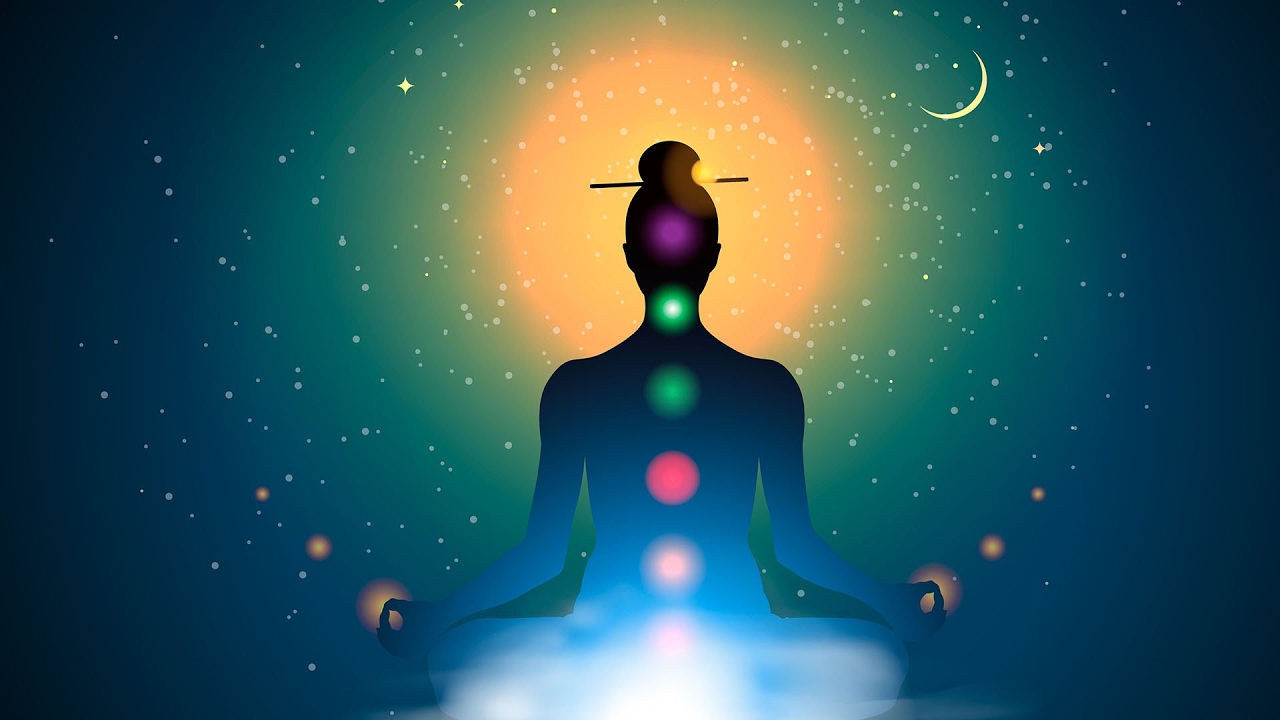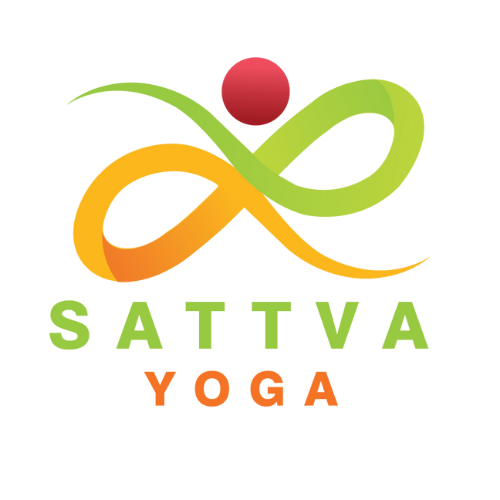
Chakras (Energy Centres)
What are Chakras?
Chakras are the energy centers of the body. They are located in the astral body, along the spine, starting at its base and running upwards to the crown of the head. The astral body is the energy body residing inside our physical body. Each physical body part has a corresponding astral body part. The astral body cannot be seen or touched. This is also a reason why we cannot see the chakras.
The chakras radiate a specific colour and energy. Each one coincides with a gland in the physical body. Since each chakra relates to specific spiritual, emotional, psychological, and physical aspects of our being, it is believed that their blockage or malfunction can lead to physical, psychological, and emotional disorders. The conscious awareness and balancing of these energy centers, on the other hand, is believed to lead to well-being and good health.
The above ties into the purpose of yoga. Through asana practice, yoga seeks to stimulate and balance these chakras or energy centers in the body. Read on to learn more about the 7 chakras, their symbols, attributes, effects, and balancing techniques.
How many Chakras are there in the body?
Mostly, we hear about the ‘seven chakras’ but, there is an infinite number of chakras in the human body. A specific vibration, color, symbol and sound are associated with all 7 chakras. Depending on whether these energy centers are healthy or blocked, you may experience different attributes of your physical, mental, and emotional health. The 7 main chakras as they appear in the body are:
1. Muladhara Chakra- Root Chakra
2. Svadhishthana Chakra- Sacral Chakra
3. Manipura Chakra- Solar Plexus Chakra
4. Anahata Chakra- Heart Chakra
5. Vishuddha Chakra- Throat Chakra
6. Ajna Chakra- Third Eye Chakra
7. Sahastra Chakra- Crown Chakra
The 7 Chakras: Symbols and Symptoms
1. Muladhara Chakra – Root Chakra
Symbol: The Root Chakra symbol consists of a 4-petalled lotus flower, a square, and a downward-facing triangle. Each element is said to represent the 4 aspects of the human mind, uniting to form the birth of the human consciousness.
Color: Red
Element: Earth
Location: The Root Chakra also known as the Muladhara Chakra is located at the base of the spine, between the anus and the genitals. It is characterized by the emotions of survival, stability, ambition, and self-sufficiency.
Symptoms of a blocked Root Chakra: When this chakra is out of balance, a person starts feeling unstable, ungrounded, lack of ambition, lack of purpose, fearful, insecure and frustrated.
Yoga poses to balance the Root Chakra:Tree Pose (Vrkshasana) and Mountain Pose (Tadasana).
2. Svadhishthana Chakra- Sacral Chakra
Symbol: The symbol for the Svadhishthana Chakra or Sacral Chakra is made up of multiple circles, a crescent moon, and six lotus flower petals. The circles and crescent moon represent the cyclical nature of life, death, and rebirth, while the 6 petals portray the 6 negative aspects of our nature that we need to overcome to open this chakra.
Color: Orange
Element: Water
Location: The Svadhishthana Chakra, more commonly known as the Sacral Chakra, is located in the lower abdomen, about four fingers below the navel. Its attributes include the basic need for sexuality, as well as creativity and self-worth.
Symptoms of a blocked/imbalanced Sacral Chakra: When the Sacral Chakra is imbalanced, a person may feel emotionally explosive and irritable, sense a lack of energy and creativity, feel manipulative, or obsessed with sexual thoughts.
Yoga poses to activate the Sacral Chakra: You can work on balancing the Svadhishthana Chakra by practicing poses like Crow Pose (Kakasana) or standing poses like Triangle Pose (Trikonasana).
3. Manipura Chakra- Solar Plexus Chakra
Symbol: The Solar Plexus Chakra symbol consists of a downward-pointing triangle within a ten-petalled lotus flower. The ten petals symbolize ten negative character traits that we have to conquer, while the triangle is the Agni tattva or fire of kundalini energy which signifies our inner strength.
Color: Yellow
Element: Fire
Location: The Manipura Chakra is located at the solar plexus, between the navel and the bottom of the rib cage. It is characterized by emotions like ego, anger, and aggression.
Symptoms of a blocked/imbalanced Solar Plexus Chakra: An imbalance of the Solar Plexus Chakra can manifest physically as digestive problems, liver problems, or diabetes. On an emotional level, one might struggle with depression, lack of self-esteem, anger, and perfectionism.
Yoga poses for Solar Plexus Chakra alignment: Working on Manipura Chakra can be done in poses like Classical Forward Bend (Paschimottanasana), Classical Cobra Pose (Bhujangasana), and Bow Pose (Dhanurasana).
4. Anahata Chakra- Heart Chakra
Symbol: In the Heart Chakra symbol, two triangles intersect to form a yantra which represents the balance of yin and yang, or upward and downward forces. Outside, there is a lotus flower with 12 petals symbolizing the twelve divine qualities associated with the heart.
Color: Green
Element: Air
Location: As the name implies, the Anahata Chakra is located in the heart region. This chakra is the seat of balance, and it is characterized by emotions of love, attachment, compassion, trust, and passion.
Symptoms of a blocked/imbalanced Heart Chakra: When the heart chakra is imbalanced, a person may deal with emotional issues like anger, lack of trust, anxiety, jealousy, fear, and moodiness.
Yoga poses to balance the Heart Chakra: Heart Chakra can be balanced by practicing poses like Half Bridge Pose (Ardha Setubandhasana), and Fish Pose (Matsyasana).
5. Vishuddha Chakra- Throat Chakra
Symbol: The symbol of the Throat Chakra consists of a 16-petalled lotus flower surrounding an inverted triangle which holds a circle within. This represents spiritual growth and the purification of the body, mind, and spirit.
Color: Blue
Element: Space
Location: The Visuddha Chakra is located at the base of the throat, coinciding with the thyroid gland. It is associated with inspiration, healthy expression, faith, and the ability to communicate well.
Symptoms of a blocked/imbalanced Throat Chakra: A blockage in the throat chakra may be experienced as timidity, quietness, a feeling of weakness, or the inability to express our thoughts.
Yoga poses for Throat Chakra balance: Throat Chakra is stimulated in poses like Shoulderstand (Sarvangasana) and Plough Pose (Halasana).
6. Ajna Chakra- Third Eye Chakra
Symbol: The Third Eye Chakra symbol consists of an inverted triangle resting in a circle between two lotus petals. The two petals and downward-facing pyramid both signify wisdom, emphasizing the Third Eye Chakra’s role in our journey to spiritual awareness.
Color: Indigo
Element: None
Location: The Ajna Chakra (pronounced as ‘Agya Chakra’) is located between the eyebrows. Also known as the Third Eye Chakra, it is often used as a focal point during asana practice to develop more concentration and awareness. It is said that meditating upon this chakra destroys the karma of past lives and brings liberation and intuitive knowledge. Its attributes are intelligence, intuition, insight, and self-knowledge.
Symptoms of a blocked/imbalanced Third Eye Chakra: When imbalanced, it may make you feel non-assertive and afraid of success, or on the contrary, it can make you more egotistical. An imbalance can manifest as physical problems like headaches, blurry vision, and eye strain.
Yoga poses to balance the Third Eye Chakra: Ajna Chakra is stimulated when practicing Headstand (Shirshasana).
7. Sahastra Chakra- Crown Chakra
Symbol: The Crown Chakra symbol is depicted as a ring of a thousand lotus petals surrounding an inverted triangle. This symbolizes the rising of divine energy into the Crown Chakra, bringing spiritual liberation and enlightenment.
Color: Violet White
Element: None
Location: The Sahastrara or Crown Chakra is located at the crown of the head. The seventh chakra is the center of spirituality, enlightenment, and dynamic thought and energy. It allows for the inward flow of wisdom and brings the gift of cosmic consciousness.
Symptoms of a blocked/imbalanced Crown Chakra: When it gets imbalanced, one might suffer from a constant sense of frustration, melancholy and destructive feelings.
Yoga poses to align the Crown Chakra: Balancing Sahasrara Chakra can be done by practicing Headstand (Shirshasana).

